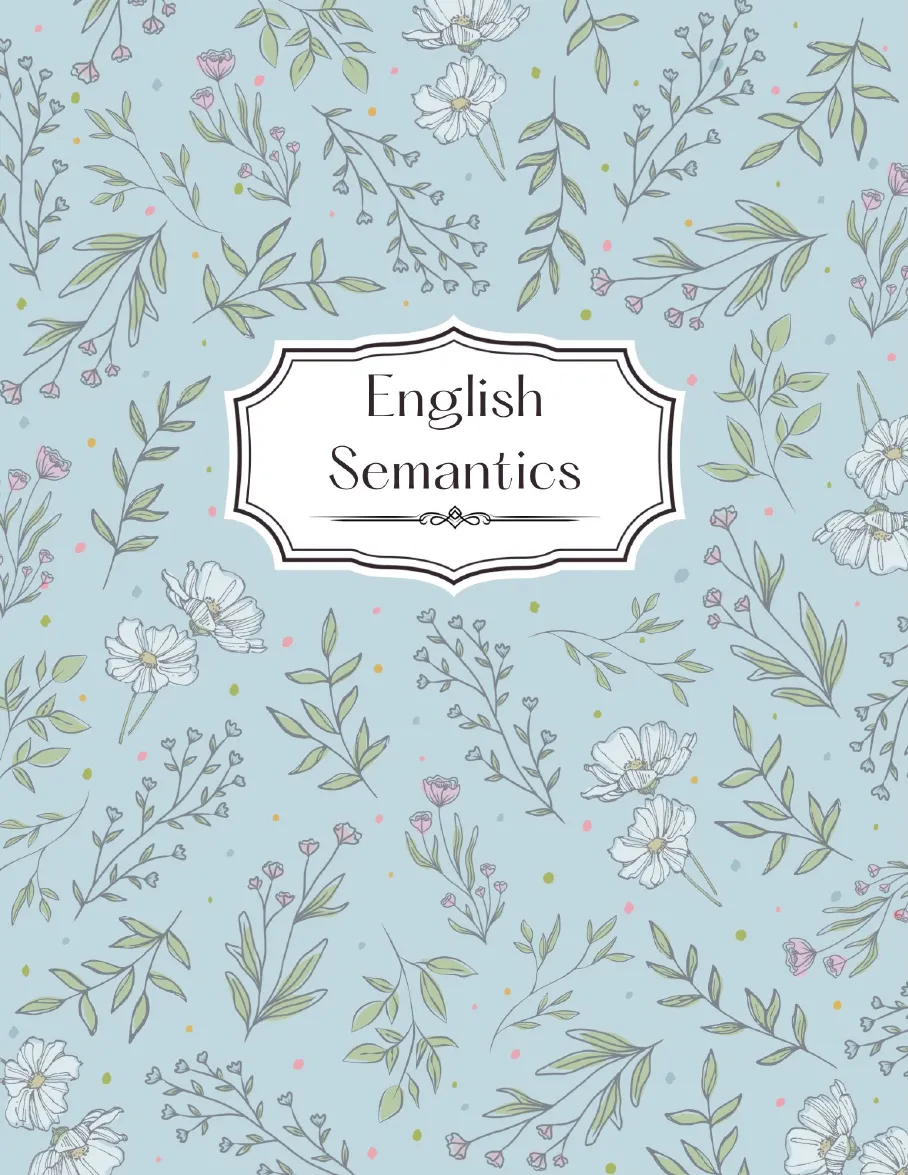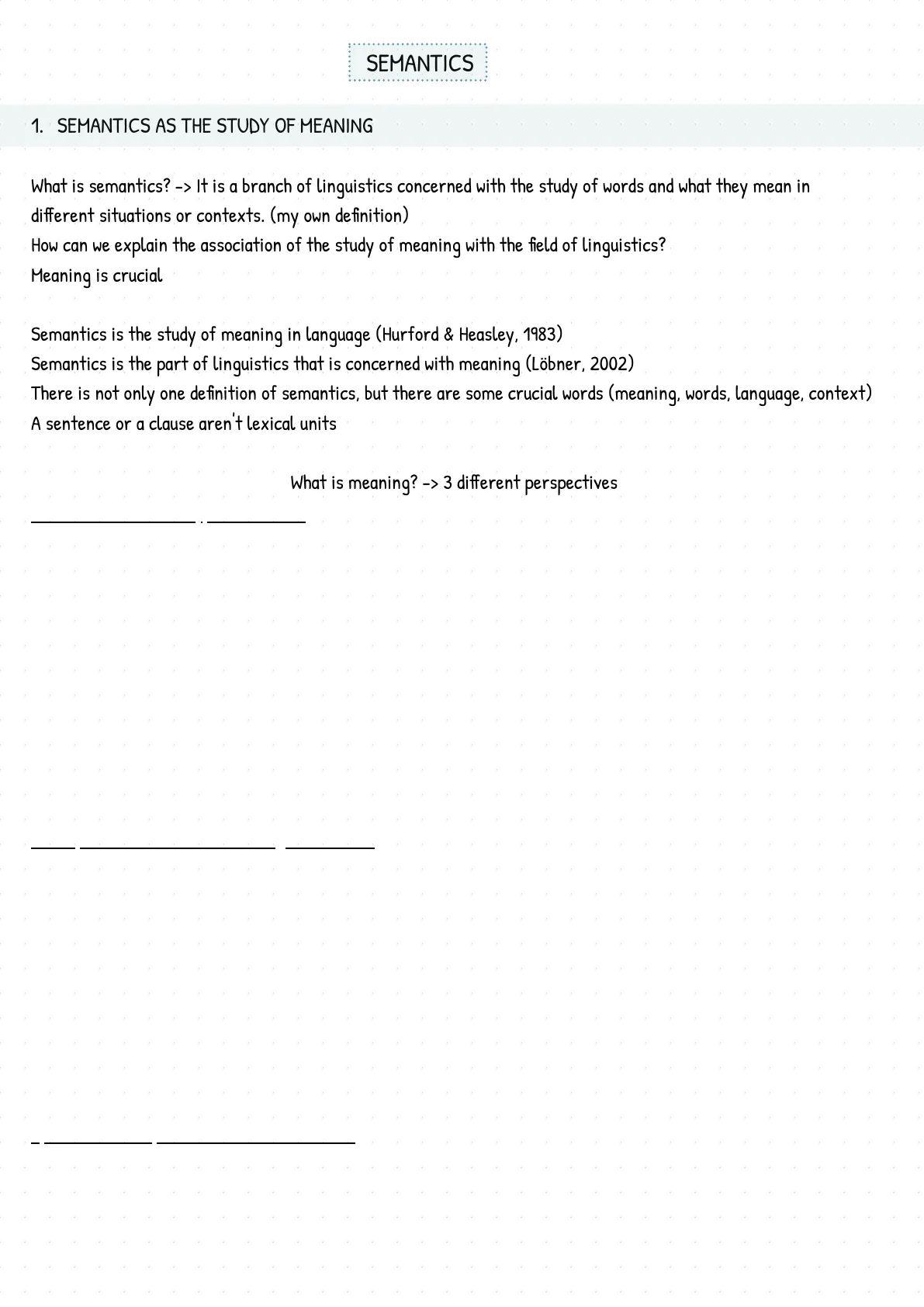English Semantics: Theories of Meaning and Categorization in Linguistics
Document from University about English Semantics. The Pdf explores various theories of meaning, including Leech's seven types and Yule's conceptual vs associative meaning. This University-level material in Languages also covers Eleanor Rosch's prototype theory, focusing on family resemblances and hierarchical categories.
See more35 Pages


Unlock the full PDF for free
Sign up to get full access to the document and start transforming it with AI.
Preview
Semantics: The Study of Meaning
English
Semantics
- SEMANTICS
- SEMANTICS AS THE STUDY OF MEANING
What is semantics? - > It is a branch of linguistics concerned with the study of words and what they mean in
different situations or contexts. (my own definition)
How can we explain the association of the study of meaning with the field of linguistics?
Meaning is crucial
Semantics is the study of meaning in language (Hurford & Heasley, 1983)
Semantics is the part of linguistics that is concerned with meaning (Lobner, 2002)
There is not only one definition of semantics, but there are some crucial words (meaning, words, language, context)
A sentence or a clause aren't lexical units
What is meaning? - > 3 different perspectives
Leech's Seven Types of Meaning (1981)
Leech's (1981) seven types of meaning
- Conceptual meaning: basic, literal, meaning -> linked to experiential metafunction/ meaning (grammar)
- Connotative meaning: Associations or implied meanings beyond the literal sense
- Social meaning: Social contexts or relationships -> interpersonal
- Affective meaning: Expresses the speaker's meanings
- Reflected meaning: Secondary meanings that arise from a word's associations ("Holy smokes" reflects surprise
and religious imagery) - Collocative meaning: Derived from a word's typical associations ("pretty" collocates with "girl" and "handsome"
with "man") - Thematic meaning: Emphasizes different elements by altering structure -> textual metafunction
Conceptual vs. Associative Meaning (Yule, 1985)
Conceptual vs associative meaning (Yule, 1985)
Associative meaning can be linked to connotative and reflected meaning.
August is the 8th month of the year -> conceptual.
By changing 8th for best we get -> August is the best month of the year -> associative (subjective), but it's
conventional because it's true for many people.
Our interpretation depends on this kind of association.
I didn't mean to disturb you -> intention
Pretty' means beautiful -> definition
Speaker meaning vs sentence/ word meaning
Dictionaries as word meaning, speaker meaning for communication in language learning
Question - Have you got the time? - > it offers two kinds of interpretation (yes/ yes, it's 9 o'clock)
Answer -Communicative exchanges: Statements, commands, questions, offers.
If we see the previous sentence as an interrogative clause, it would we a question, if were thinking about an
intention of asking for an answer, it would be a command, because we want an answer.
We're talking about speaker meaning from Hurtford, Heasley and Smith.
Words are containers of meaning.
Wife my under doesn't stand me! - > multimodal communication
It's difficult to explain what's going on in linguistic terms.
The structure of the sentence is mixed. It's not the expected order (my wife doesn't understand me)
Oddness' due to structuring -> 'oddness' due to unexpectedness (our expectations)
The meaning of words from the perspective of words as containers of meaning
Possible sentences/ combinations with CAR BOUGHT A NEW MEGAN PETE
Pete bought Megan a new car
Megan bought Pete a new car
Pete bought a new Megan car -> Polysemic
Car bought Megan a new Pete -> This one wouldn't make sense because we don't associate cars as living things,
while Pete and Megan are living things.
Words also have roles for interpreting meaning (semantic roles) -> depending on our approach to meaning we
have different lists. Yule's interpretation is different to Halliday's perspective. - > Task 1
-> From Halliday's perspective, Megan would be an actor (as it's a material process)
Collocations: We can tell a word by the company it keeps.
Homework: Answer the following questions: Read Chapter 9. Semantics and carry out the following activities:
- Read all the chapter and identify unclear or challenging parts. Bring your questions to class, or ask for more
recommended readings if you prefer to work on your own. - How similar / different are the semantic roles described by Yule when compared to Halliday's participant roles in
experiential meaning that you studied in English Grammar? Compare them in the following sentence:
She saw a mosquito on the wall. - Is the sentence above ambiguous?
1. Outline the main concepts and key terms of the different types of lexical relations according to Yule. Find at
least one example of each in English (different from those given by him). - > HomeworkWhen looking at semantics, we're also looking at collocations (different kinds of meaning and how it is constructed)
- For example, abandoned at birth, abandoned the traditional secure, feel abandoned.
- Collocations are not in the same section as lexical relations. WHY? Try to find examples and compare them
We try to recognize patterns in language (the program of wordsmith tools or the BBI Combinatory Dictionary of
English along with linguee or deepl), for example the words it usually appears with -> "You can tell a word by the
company it keeps". Words tend to co-occur with others at the same time -> this is the type of knowledge we don't know
when we start to learn a language.
Locating Semantics within Linguistics
1.2. Locating semantics within linguistics
What areas of linguistics can you recognize? (Identifying different areas of enquiry in linguistics)
- Semantics (the study of meaning in linguistics)
- Morphology (the study of morphemes, so the study of meaning of how words are formed)
(12 vowel sounds in
English) - Sociolinguistics: How do people use language depending on their social group.Connected
with people, social groups. The methods used to study it are developed by sociology.
We study age range, socioeconomic group, ethnical background, gender ... (it depends on the place). - Pragmatics: The meaning of language in a context
- Grammar: The norms of a language (trad. the rules). We cannot separate the structure from lexis. How language
behaves. - Phonetics: The science which studies the characteristics of human sound-making, especially those sounds in speech,
and provides methods for their description, classification and transcription. The realization of the forms in
phonology. - Phonology: A branch of linguistics which studies the sound system of language (more general)
Structure and Combination of Words
Syntax: The structure of language and the combination of words from a formal approach. Impose some kind of
understanding of what's going on in kinds of structure. Different types of language we can recognize in a language.
- Neurolinguistics: How the brain produces and understands language
- Historical linguistics: Language use according to time (perspectives on how language is constructed).
- Corpus linguistics: The study of a large collection of electronic texts.
- Dialectology: The study of language variation (geographical use)
. Word formation: How neologisms are formed (connected with morphology)
A rule = obligation
A norm = normal,
not restrictive - Forensic linguistics: Looking into language in order to provide evidence in court.
For example, plagiarism or murder (e.g. regularity on your way of speaking via your phone). - Computational linguistics: The use of software to study how you can talk to, e.g. your phone and language
recognition, how a model can be created to speak like a human. About human translation. - Discourse analysis: How language is constructed.Psycholinguistics
Clinical linguistics: How some diseases affect the use of language
First language acquisition
Second language acquisition/ learning: learning it in the place where it is
spoken (e.g. immersion courses).
Sign language
Historical linguistics
Language variation: In relation to dialectology, but it also covers how
Once upon a time: Typically used in
tales (genre), at the beginning of a
sentence (position), lexically
unspecific. It goes in a chunk, it's not
isolated. Functions as a trigger that
a story is about to begin.
different the language is when we compare it to different groups of people,
not necessarily like sociolinguistics.
Language varieties: Not in relation to geographical areas, but for instance in relation to "motherese" (how mothers
speak to their babies, e.g. intonation)
Animal languages: Properties in human vs non-human language (they have fixed reference, which doesn't allow them
to create new language, lack of creativity).
POV: 1. Theoretical linguistics: Produce theories about how language works, or how it is like in different areas
2. Descriptive linguistics: Concerned with many diff. areas (describing language)
3. Applied linguistics: Dealing how to teach/ learn a language
-> The three of them are related and go in conjunction
Theoretical
Descriptive
Applied
Semantics and Pragmatics
Semantics and pragmatics
Pragmatics can be described as the study of language use; how language interacts with context. The domain of
pragmatics is generally viewed as excluding those aspects of meaning that fall into the realm of semantics.
Homework: Murphy and Koskela (pages 124 & 125): What is the relationship between semantics and pragmatics?
Semantics is concerned with the literal, context-independent meaning of words and sentences, focusing on
conventional meaning and truth-conditional meaning. Pragmatics, on the other hand, deals with context-dependent
meaning, non-conventional meaning, and the speaker's intended meaning, which includes implicatures and the use
of language in social contexts.
Is this relationship accredited by all linguistics? If not, why not?
No, it is not. The reason for this is that the various dimensions along which semantics and pragmatics may be
demarcated do not exactly overlap. For example, the literal meaning of a sentence is not purely independent of
context, as it relies on context-dependent processes such as assigning reference and resolving ambiguities./ Many
have also pointed out that the various dimensions along which semantics and prag- matics may be demarcated do
not exactly overlap. For example, the literal meaning of a sentence is not purely independent of the context, but
relies on context-dependent processes such as assigning reference, and resolving any ambiguities.Why are collocations not in the same section as lexical relations?
Collocations are not typically included in the same section as lexical relations because they involve a different type
of relationship between words. Lexical relations, such as synonymy, antonymy, hyponymy, and meronymy, are
semantic relationships that exist between individual lexemes based on their meaning. Collocations, on the other
hand, are combinations of words that frequently occur together in a language and form a conventional unit. They
are not based on a direct semantic relationship between the words themselves but rather on the habitual co-
occurrence of these words in speech or writing.
Collocations -> lexical relations (how do words relate to one another)? - > know this by hard
with reckless abandon, black coffee -> if they appear together (we're talking of co-appearance
happiness - joy: it's either one or the other -> synonym (the same conceptual meaning) -> what's the
connection between the two?
Hedging: -
When we look at the different relations (man, he, Peter) vertically, it's a paradigmatic relation. The three of them
belong to the realm of the nominal.
Looking at the structure of the sentences horizontally we have syntagmatic relations (sintagmas)
Semantics and pragmatics
SEMANTICS:
Context- independent meaning
Conventional meaning
Literal meaning
Truth- conditional meaning
Stored representations in the mind
PRAGMATICS:
Context- dependent meaning
Non- conventional meaning
Speaker meaning (what's implicated)
Non-truth. conditional meaning
On-line processing
Examples
That's twenty pounds, sir -> a comercial transaction
That's a very nice green lion, Joey -> a close relationship between an adult and Joey (a child)
-> The fact that all of us interpret this scenario as such it's that the meaning constructed in this way builds the
context.
To describe meaning in both we can't look at the structure, but at the context.